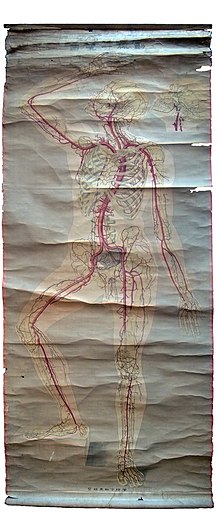Imada Tsukanu
Imada Tsukanu ( Japanese 今 田 束 ; * September 1850 in Iwakuni ( Japan ), † November 22, 1889 in Tokyo ) was a physician of the Meiji period and an influential pioneer of Japanese anatomy.
Life
Imada was born as the third son of Satō Itsu ( 佐藤 逸 ), a samurai of the Iwakuni clan ( Suō Province , now eastern part of Yamaguchi Prefecture ), but adopted by the Imada family in 1862. In 1867 he moved to Osaka and Kyoto as a member of a troop of the Iwakuni clan to overthrow Tokugawa rule. During the Boshin War he took part in the battle of Toba-Fushimi on the side of the defenders of the Tennō . In the fourth year of the new Meiji government, he applied to the guard of the Tenno and went to Tokyo.
He also learned for some time from Mitsukuri Shūhei ( 箕 作 秋 坪 ), one of the outstanding representatives of the Holland customers ( Rangaku ), in his school Mitsumata-Gakusha ( 三叉 学 舎 ), but then switched to the more liberal school founded by Fukuzawa Yukichi Keiō Gijuku ( 慶 應 義 塾 ), in whose register (Volume 1) he is listed under number 345.
In 1872 he said goodbye to military service and went as a simple assistant to the new "Medical School Number 1", a pioneering institution for the spread of Western medicine. In the following year he was officially employed as an assistant in the Department of Anatomy . In this function he supported the German physician and naturalist Friedrich Karl Wilhelm Dönitz . In 1874 the institution was renamed “Tokyo Medical School”. Imada gradually received more important tasks in the anatomical education of the students. In 1877 the medical school was opened in the new Tokyo University . In the same year he became an academic assistant to the first Japanese anatomy professor Taguchi Kazuyoshi ( 田 口 和美 , 1839-1904), 1881 assistant professor and 1886 professor of anatomy.
In the same year, 1877, he developed a means for better preservation of corpses. Imada produced a large number of anatomical specimens. The anatomical doll he developed has also been shown at exhibitions in Europe and America. The teaching materials published by him include a. Japanese editions of anatomical charts by the German anatomist Robert Friedrich Froriep (1804–1861). Among his essays we also find one in German (position of the inner ear) in the "Communications from the Medical Faculty of the Imperial Japanese University" (1887).
Imada's most important work is the textbook “Practical Anatomy” ( 実 用 解剖学 Jitsuyō kaibōgaku ) published in 1887 and distributed in over 30 editions . The edition of 1888 was translated into Korean by the Korean doctor Kim Pil-Sun ( 金 弼 淳 , 1878-1919) and his teacher, the Canadian missionary and doctor Oliver R. Avison (1860-1956), and published in 1906 under the title "Anatomy" ( Haebuhak 해부학 ) published. This was the first Korean textbook on anatomy in the western style.
Imada died of typhus at a young age.
Works
- Imada Tsukanu: Jitsuyō kaibōgaku . Tokyo, 1887, 1888, 1889, 1891, 1892, 1895, 1901, 1905, 1912, 1913, 1930 ( 今 田 束 著 『実 用 解剖学』 )
- Dōmyaku Ichiranzu . Tokyo, 1878 ( ロ ベ ル ト ・ フ ロ リ ー プ [著]; 今 田 束 [訳] 『動脈 一 覧 図』 )
- Shinkei Ichiranzu . Tokyo, 1878 ( ロ ベ ル ト ・ フ ロ リ ー プ [著]; 今 田 束 [訳] 『神 経 一 覧 図』 )
- Shinzō oyobi naizō ichiranzu . Tokyo ( 『心 臓 及 内 臓 一 覧 図』 )
literature
- Keiō Gijuku nyūshachō , dai 1kan. Fukuzawa Yukichi Research Center (ed). Keio Gijuku, 1986 『慶 應 義 塾 入社 帳 第 1 巻』 福澤諭吉 研究 セ ン タ ー (編)
- Okano Tatsuo: Imada Tsukanu sensei no shōgai to gyōseki - Meiji-zenki no kaibōgakusha 1-6 (Life and achievement of Imada Tsukanu - an anatomist of the early Meiji period). In: Yamaguchi-ken Ishikaihō, No. 1780 (2008), 1781 (2009), 1782 (2009), 1787 (2009), 1788 (2009) ( 吉岡達 生 「今 田 束 先生 の 生涯 生涯 業績 ー 明治 前期 の 解剖学 者」、『 山口 県 医師 会 報 』 )
- Michel, Wolfgang: On Ōe Okuji's Dōmyaku Ichiranzu and its Background . (W ·ミヒェル「大江億司写「動脈一覧図」とその背景について」.ミヒェル·ヴォルフガング,吉田洋一,大島明秀共編「史料と人物IV」中津市歴史民俗資料館分館医家史料館叢書12, 2013) ( Digitized, Kyushu University )
- National Hangeul Museum: I am the body: the anatomy of Hangeul in the enlightenment period . Seoul, 2018 ( 국립 한글 박물관: 나는 몸 이로 소이다: 개화기 한글 해부학 이야기 )
Remarks
- ↑ According to the Japanese calendar, born in the 3rd year of Kaei, died in the 22nd year of Meiji.
- ↑ T. Okano published a detailed description of his life and his achievements in the " Bulletin of the Medical Association of Yamaguchi Prefecture" ( Yamaguchi-ken Ishikaihō )
- ↑ Keiō Gijuku nyūshachō
- ↑ Chinese-Korean name 魚 丕 信 . Avison is considered the founder of Western medicine in Korea. On him goes u. a. the founding of Severance Hospitals and the Severance Medical College, which later merged to form Yonsei University College of Medicine .
- ↑ More on this in Volume I am the body of the National Hangeul Museum, Seoul.
- ↑ Edited by Roberti Froriepi Icon synoptica arteriarum corporis humani in uno sceleto conjunctim descriptorum . Weimar, 1850.
- ↑ processing Roberti Froriepi Icon synoptica nervorum corporis humani in uno sceleto conjunctim descriptorum in tribus tabulis Weimar 1850th
| personal data | |
|---|---|
| SURNAME | Imada, Tsukanu |
| ALTERNATIVE NAMES | 今 田 束 (Japanese name) |
| BRIEF DESCRIPTION | Japanese medic, pioneer of western anatomy |
| DATE OF BIRTH | September 1850 |
| PLACE OF BIRTH | Iwakuni , Japan |
| DATE OF DEATH | November 22, 1889 |
| Place of death | Tokyo |


